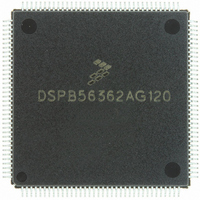DSPB56362AG120 Freescale Semiconductor, DSPB56362AG120 Datasheet - Page 112

DSPB56362AG120
Manufacturer Part Number
DSPB56362AG120
Description
IC DSP 24BIT AUD 120MHZ 144-LQFP
Manufacturer
Freescale Semiconductor
Series
Symphony™r
Type
Audio Processorr
Datasheet
1.DSPB56362AG120.pdf
(152 pages)
Specifications of DSPB56362AG120
Interface
Host Interface, I²C, SAI, SPI
Clock Rate
120MHz
Non-volatile Memory
ROM (126 kB)
On-chip Ram
42kB
Voltage - I/o
3.30V
Voltage - Core
3.30V
Operating Temperature
-40°C ~ 85°C
Mounting Type
Surface Mount
Package / Case
144-LQFP
Device Core Size
24b
Architecture
Modified Harvard
Format
Fixed Point
Clock Freq (max)
120MHz
Mips
120
Device Input Clock Speed
120MHz
Ram Size
42KB
Program Memory Size
90KB
Operating Supply Voltage (typ)
3.3V
Operating Supply Voltage (min)
3.14V
Operating Supply Voltage (max)
3.46V
Operating Temp Range
-40C to 105C
Operating Temperature Classification
Industrial
Mounting
Surface Mount
Pin Count
144
Package Type
LQFP
Product
DSPs
Data Bus Width
24 bit
Processor Series
DSP563xx
Core
56000
Numeric And Arithmetic Format
Fixed-Point
Instruction Set Architecture
Modified Harvard
Device Million Instructions Per Second
120 MIPS
Maximum Clock Frequency
120 MHz
Program Memory Type
Flash
Data Ram Size
42 KB
Operating Supply Voltage
3.3 V
Maximum Operating Temperature
+ 105 C
Mounting Style
SMD/SMT
Interface Type
SPI, I2C, ESAI, SHI
Minimum Operating Temperature
- 40 C
Lead Free Status / RoHS Status
Lead free / RoHS Compliant
Available stocks
Company
Part Number
Manufacturer
Quantity
Price
Company:
Part Number:
DSPB56362AG120
Manufacturer:
FSC
Quantity:
12 000
Company:
Part Number:
DSPB56362AG120
Manufacturer:
FREESCA
Quantity:
273
Company:
Part Number:
DSPB56362AG120
Manufacturer:
Freescale Semiconductor
Quantity:
10 000
Part Number:
DSPB56362AG120
Manufacturer:
N/A
Quantity:
20 000
PLL Performance Issues
One way to evaluate power consumption is to use a current per MIPS measurement methodology to
minimize specific board effects (i.e., to compensate for measured board current not caused by the DSP).
A benchmark power consumption test algorithm is listed in Appendix A. Use the test algorithm, specific
test current measurements, and the following equation to derive the current per MIPS value.
where :
5.4
The following explanations should be considered as general observations on expected PLL behavior.
There is no testing that verifies these exact numbers. These observations were measured on a limited
number of parts and were not verified over the entire temperature and voltage ranges.
5.4.1
The phase skew of the PLL is defined as the time difference between the falling edges of EXTAL and
CLKOUT for a given capacitive load on CLKOUT, over the entire process, temperature, and voltage
ranges. As defined in
greater than or equal to 0.0 ns and less than 1.8 ns; otherwise, this skew is not guaranteed. However, for
MF < 10 and input frequencies greater than 10 MHz, this skew is between −1.4 ns and +3.2 ns.
5.4.2
The phase jitter of the PLL is defined as the variations in the skew between the falling edges of EXTAL
and CLKOUT for a given device in specific temperature, voltage, input frequency, MF, and capacitive load
on CLKOUT. These variations are a result of the PLL locking mechanism. For input frequencies greater
than 15 MHz and MF ≤ 4, this jitter is less than ±0.6 ns; otherwise, this jitter is not guaranteed. However,
for MF < 10 and input frequencies greater than 10 MHz, this jitter is less than ±2 ns.
5-4
•
•
Disable unused peripherals.
Disable unused pin activity (e.g., CLKOUT, XTAL).
I
I
F2
F1
typF2
typF1
PLL Performance Issues
Phase Skew Performance
Phase Jitter Performance
= current at F2
= current at F1
= high frequency (any specified operating frequency)
= low frequency (any specified operating frequency lower than F2)
F1 should be significantly less than F2. For example, F2 could be 66 MHz
and F1 could be 33 MHz. The degree of difference between F1 and F2
determines the amount of precision with which the current rating can be
determined for an application.
Figure
1MIPS
3-1, for input frequencies greater than 15 MHz and the MF ≤ 4, this skew is
=
1MHz
DSP56362 Technical Data, Rev. 4
=
I (
NOTE
typF2
–
I
typF1
)
×
(
F2 F1
–
)
Freescale Semiconductor











